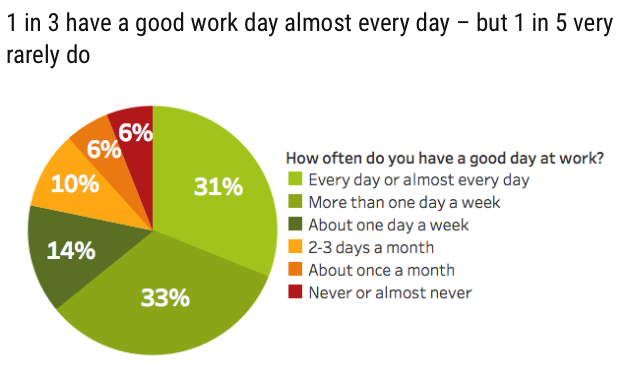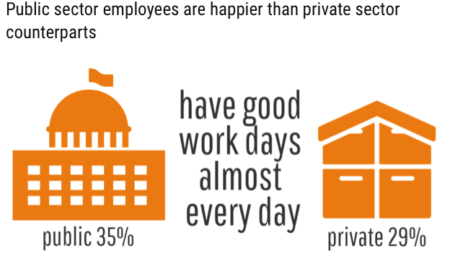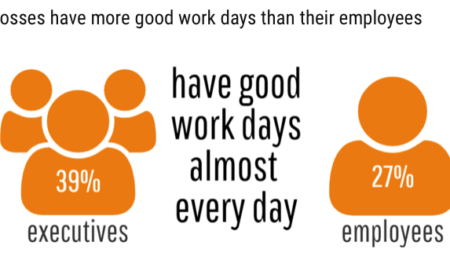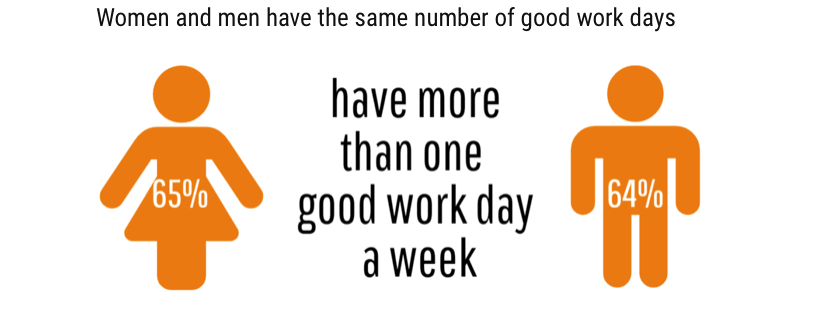
The latest survey “Good days at work” conducted by Woohoo Inc-Happiness at Work on 2,500 people worldwide, shows that one worker out of three has a good work almost every day, but one out of five rarely does.
And 22% of people experience only 1 or maximum 3 good days at work in a month, so 80-90% of these people’s working life is flat or negative.
To create an happy workplace is possible, but it need to understand the real meaning of happiness. In her second article for WOW! about Happiness at Work, Daniela Di Ciaccio co-founder at 2BHappy Agency tries to dispel some myths.
The data from Woohoo’s survey confirm the Gallup’s global surveys showing, for the past few years, the percentage of who are really “involved” in their work is only 13% (against a 63% of unmotivated and 24% of workers who even “row against”). For many of us going to work every day is tiring and depressing!
Yet to create happy workplaces it need to dispel some myths about the really meaning of happiness and what really makes people happy at work.
And above all we must avoid the pitfall of some common “realistic objections” that often create rooted mythes.
Myth # 1: money makes happiness, …up to a point!
Research on happiness and income has shown that satisfaction increases in relation to the increase in earnings, but up to a limit of about $ 75,000 a year. (Source:T. Jebb, L.Tay, E. Diener, S. Ohishi, Happiness, income satiation and turning points around the world, 2018).
Myth # 2: the more holidays I get, the happier I am?
A greater number of days away from the office only helps if we detest the work we do. And anyway, even if we love our work, the satisfaction connected to the “holidays” is relative. Humans get used to everything, even to holidays, so the general level of happiness does not increase.
(Source: Appelo J. (2016), Managing for Happiness: Games, Tools, and Practices to Motivate Any Team, John Wiley & Sons Inc).
Myth # 3: making a career makes you happy, …just for a little while!
Some psychologists have monitored top managers for five years, measuring their satisfaction before and after each job change. Surprisingly, although there were high peaks of satisfaction at the time of transition to a new job, within a year the level dropped dramatically.
What really works?
To answer this question, the first and fundamental step is to distinguish the concept of satisfaction at work from that of happiness, because the results they produce in terms of motivation, engagement and productivity are also different.
Job satisfaction is what you think of your job. Happiness at work is how you feel at work.
The first is the result of a rational evaluation, the second of an emotional experience.
Ask yourself: what would make me happy at work tomorrow?
Many of us would probably answer: more money, more time available, less meetings, canteen, flexible time, and so on …
But if the question is: what made me happy at work in the last week?
The answers we give are focused around three factors: good relations with colleagues and leaders; the realization of results that have a sense for ourselves and for others, that is the perception of having contributed to making some difference; the possibility of putting oneself in one’s work and influencing the activities that take place, in a certain level of autonomy.
Satisfaction and happiness produce different results on motivation and performance.
Research shows that to achieve true and healthy engagement it is necessary to ensure both the satisfaction of economic needs, status and career, and above all happiness, which comes from work with a clear purpose and gives meaning to what you achieve, in a decision-making autonomy, healthy and trusted context of relationships.
(Source: A. Kjerulf, 2017. Leading with Happiness, Woohoo Press, and Laloux F. 2016).
Text by Daniela Di Ciaccio, 2BHappy Agency.
Upper photo courtesy OutPlace Yourself;
infographics by “Good days at work” © Woohoo.




















